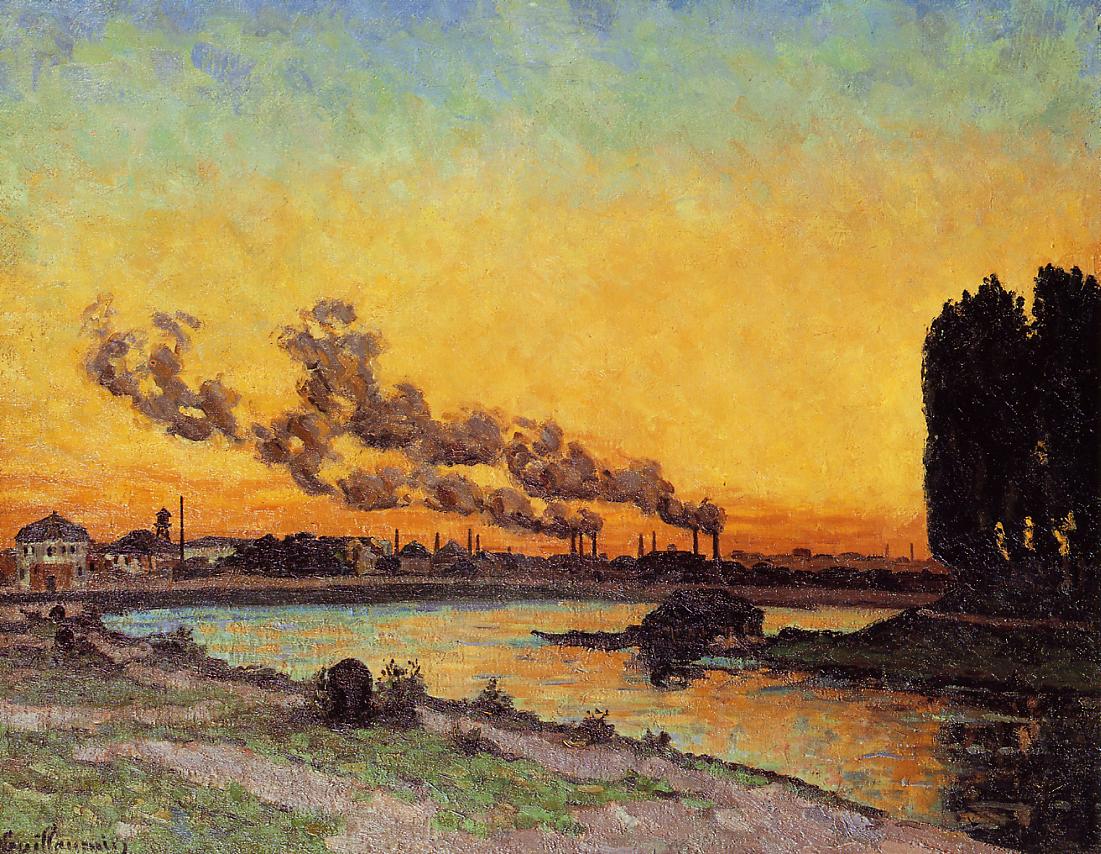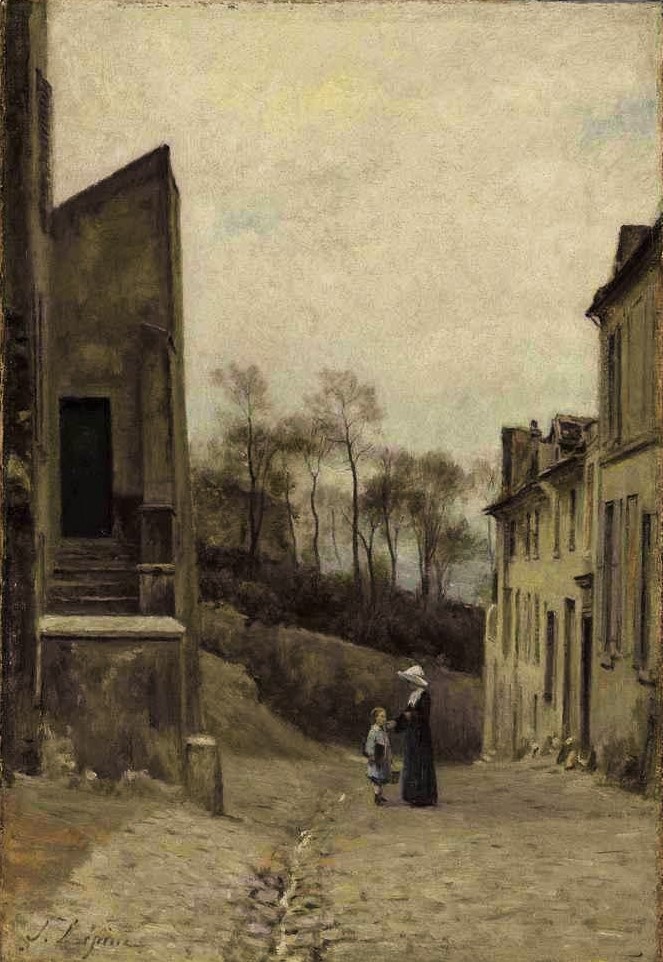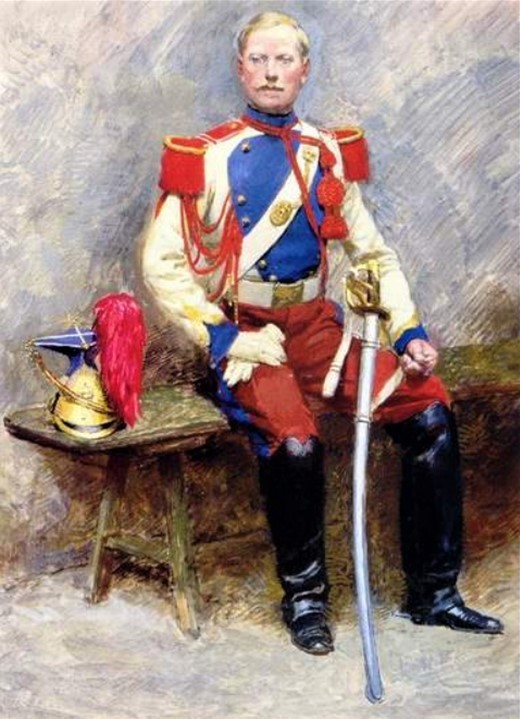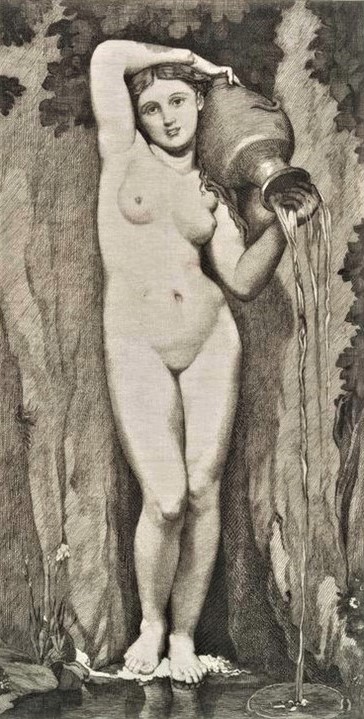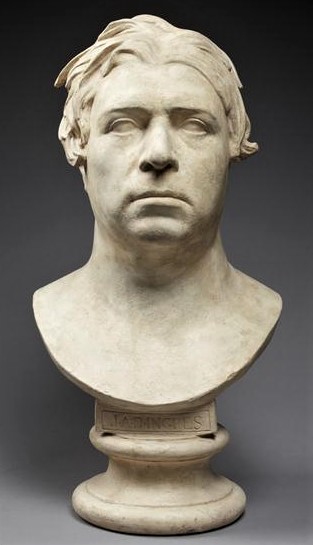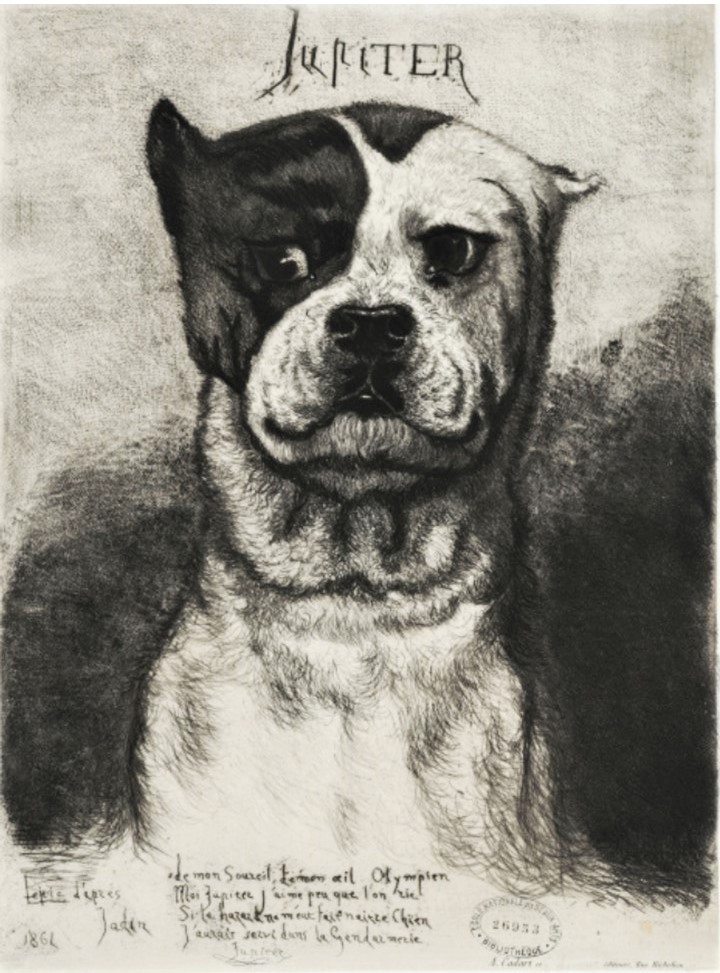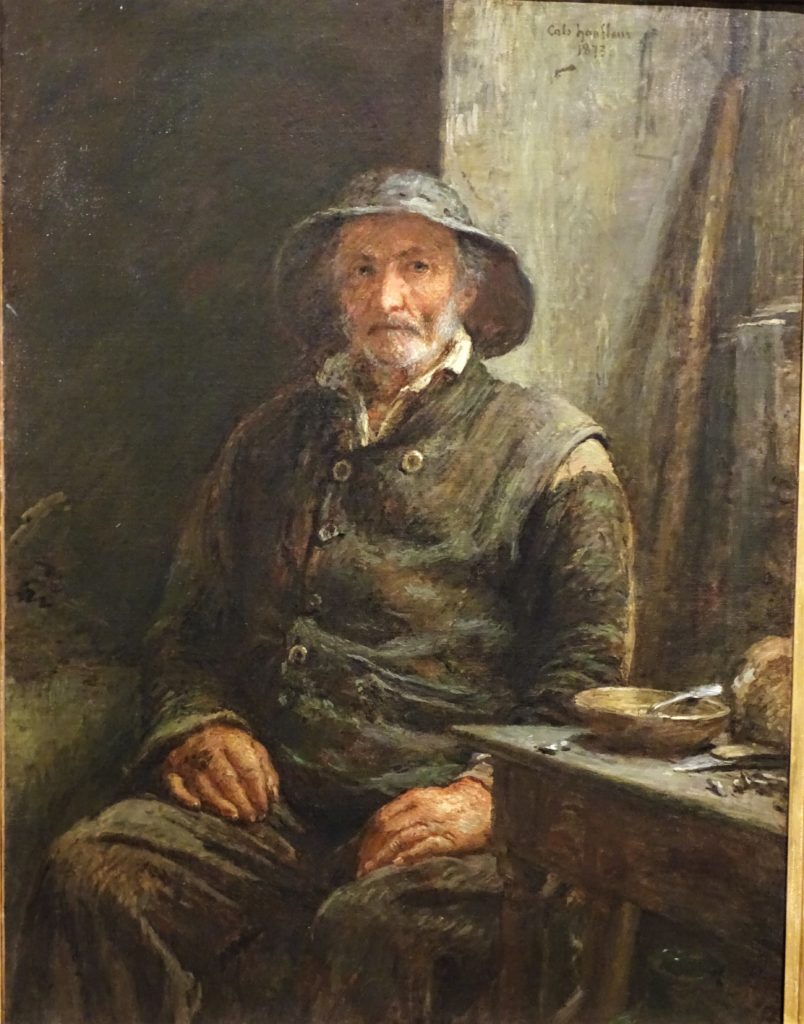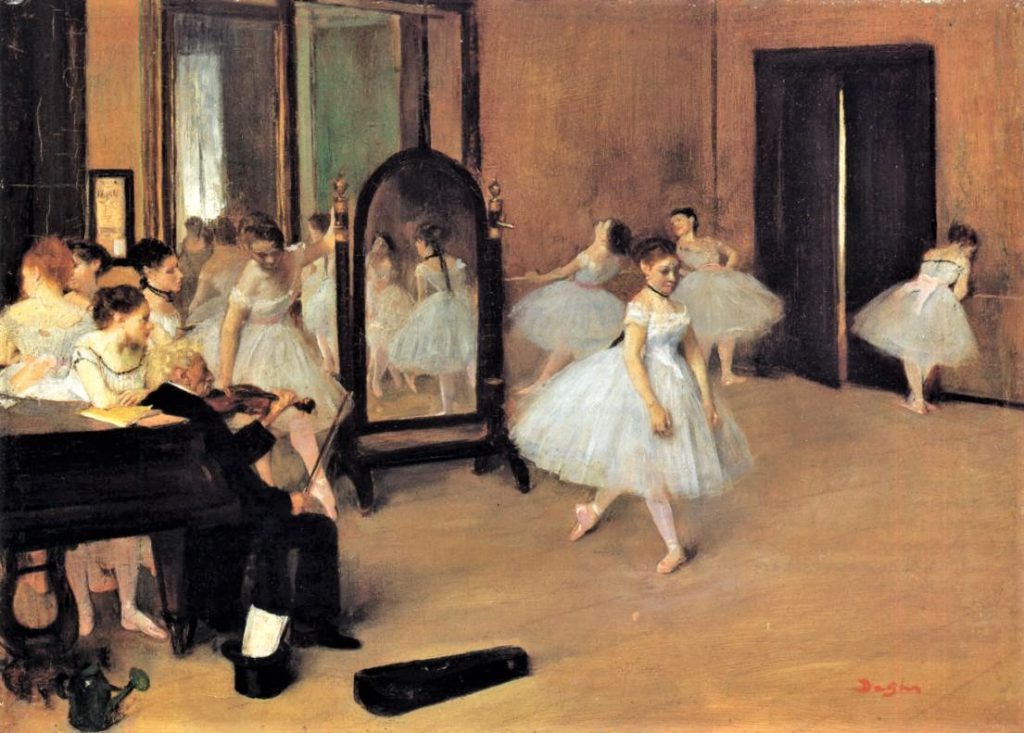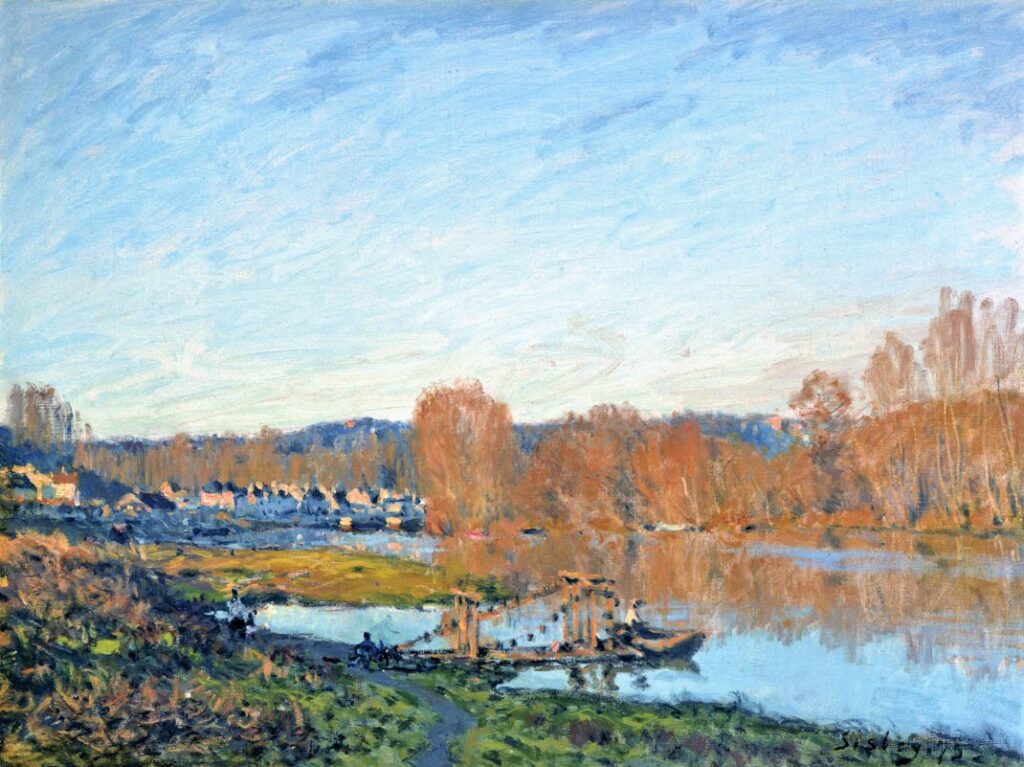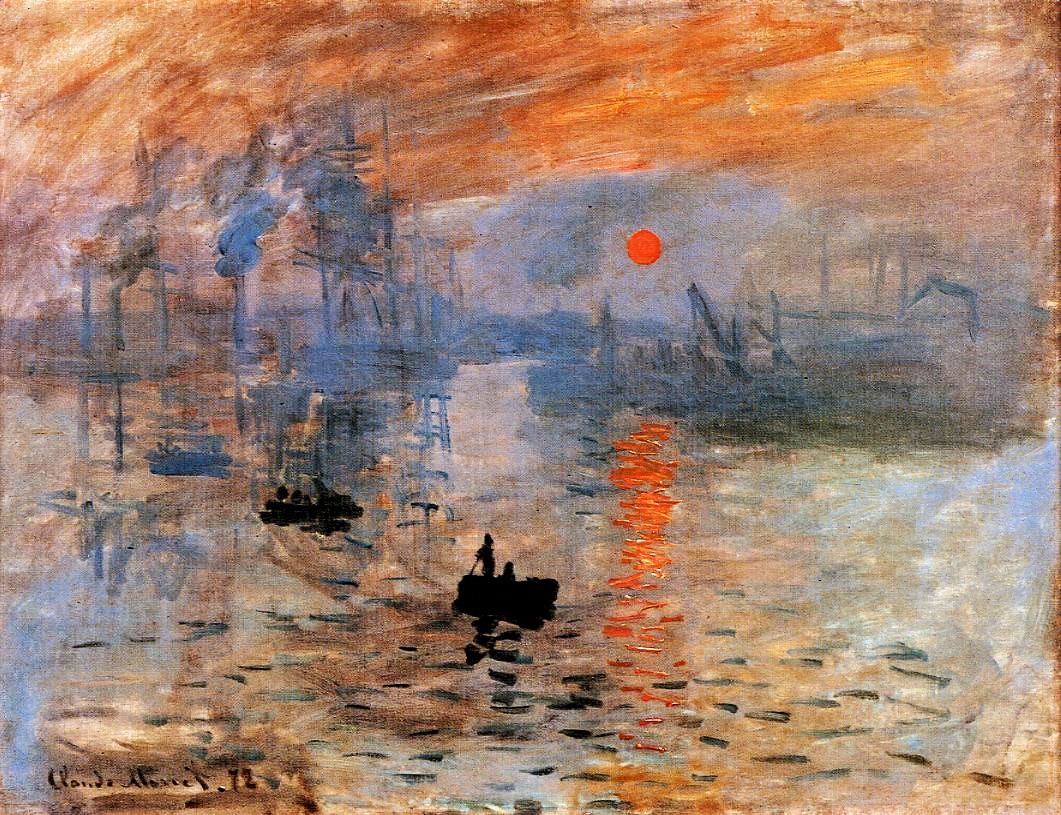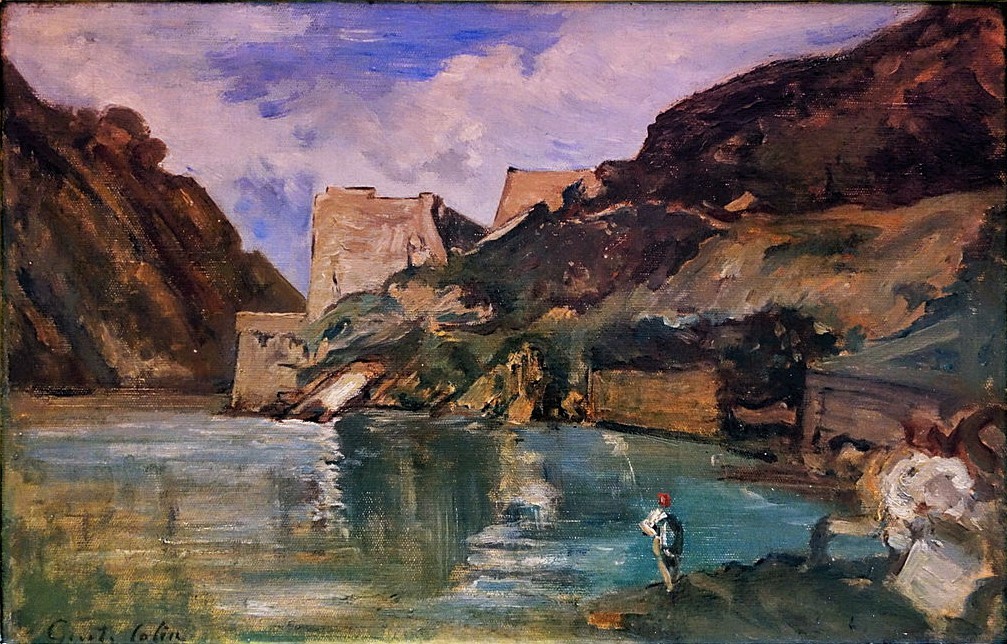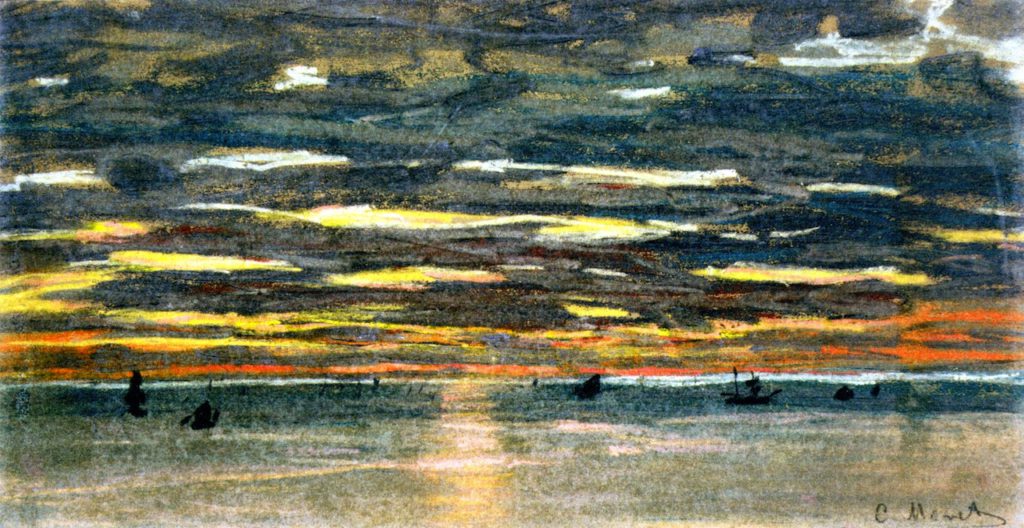Impressionism: a historical reconstruction
The 1st ‘impressionist’ exposition
1874
extended overview
Introduction:
In 1874 at the 1st ‘impressionist’ exposition 31 partakers showed about 225 art-works (165 catalogue numbers), see the slideshow and an overview of the contemporary reviews. It was organised by the ‘Société anonyme des artistes peintres, sculpteurs, graveurs, etc‘. Less than half of the art-works exhibited were oil paintings. Félix Bracquemond showed 32! engravings, Auguste Ottin several néo-classical sculptures and Claude Monet several pastels. 15 partakers wouldn’t return and continued exhibiting at the Salon.
On this page you will find an overview of this exposition, with extended information on the partakers, the used techniques and the reviews. See also the video on my YouTube channel “enjoy.impressionism”.
The start of the ‘impressionist’ expositions:
The 1st ‘impressionist’ exposition was held in 1874 in Paris. It was organised by the ‘Société anonyme des artistes peintres, sculpteurs, graveurs, etc‘. It was called the ‘première exposition 1874‘ and was held at 35, Boulevard des Capucines in the former Nadar studio (at the corner of the Rue Daunou). The doors opened Wednessday the 15th of April and closed Friday the 15th of May.
At this exposition 30+1hc=31 partakers showed at least 225 art-works, which is much more than the 165 numbers in the catalogue. (See slide show.) Just about 45% of these art-works were oil paintings. Félix Bracquemond showed far out the most (=33) works, including 32 etchings. Many other techniques were exhibited, including about 17% aquarelles.
None, of the partakers did use a fully mature impressionist painting style, maybe Sunset at Ivry↑ of Guillaumin (no.64) was the most impressionist painting exhibited. Several art-works, namely enamels of Alfred Meyer and sculptures of Auguste Ottin, even had Néo-Classical themes and Ingres was honoured in 3 art-works↓↓ (catalogue nos.24-12 +25-5 +126). About 3500 people visited the exposition. The reviews were quite positive and it was Castagnary in a positive review who explicitly called them “impressionist”, explicitly referring to Impression, soleil levant↓ of Monet and not Leroy as the ever repeated myth about Impressionism tells us.
On this page you will find information on the organisation, the partakers, the used techniques, the lenders, the reviews and the results. See also the video on my YouTube channel “enjoy.impressionism“.
1874: the organisation:
The first ‘impressionist’ exposition was organised by Degas, Monet, Pissarro and Renoir and presented under the auspices of the ‘Société anonyme des artistes peintres, sculpteurs, graveurs, etc‘, that was founded 1873/12/27. Probably modest sales had given them confidence that the exposition could be a success. Père Martin was the business leader or provisional manager of the exposition. Edmond Renoir edited the catalogue.
Renoir did most of the hanging. The display of the art-works, maybe partly was alphabetical, but not fully. Probably all the works of an artist hung together, though it is possible that drawings and pastels and maybe aquarelles were hung seperately. There were two floors with 6 or 8 rooms. According to Burty the walls were brown-red, there were draperiesand at dusk there was gas lightning. The paintings were hung in 1 or 2 rows, the small ones beneath the large.
Renoir later would say that (in 1874) he objected against using a title with a more precise meaning. A year before Alexis already had written that ‘They only want to unite interests, not systems’ (R88II,p231).
Sources: R1,p310+313+318+339; R2,p55+93+118; R3,p135; R5,p86; R88II,p231-234; R90I,p3; R87,p224; R177,p27+39; aR5; aR8=iR424.
1874: the partakers:
There were 30 + 1hc = 31 partakers showing about 225 art-works of which only half were oil paintings (see slideshow). Comtesse de Luchaire (a pseudonyme) was exhibiting outside the catalogue (=hors catalogue =hc) (R2,p123). All the following exhibitions there would be less than 20 partakers. Félix Bracquemond exhibited far out the most art-works (33 of which 32 etchings). The partakers showed just an average of 7 art-works each. The total amount of the exhibited works will stay uncertain, because the catalogue was not very accurate.
Camille Pissarro would be the only artist who joined all 8 ‘impressionist’ expositions. The majority of the participants had earned reputations at the Salon, something Degas pleaded for and Pissarro was opposed to. Degas wanted to prefend, that the exposition looked like a Salon-des-Refusés.
15 of the partakers would never would exhibit again at the ‘impressionists’ expositions, this is 26% of all the partakers: Astruc, Attendu, Boudin, Brandon, Colin, Debras, Latouche, Lépine, Comtesse de Luchaire, Meyer, de Molins, Mulot-Durivage, de Nittis, Auguste Ottin and Robert. The following 5 partakers would join 1 more time: in 1876: Béliard, Bureau, Lépic and Léon Ottin and in 1877: Cézanne. The other 11 partakers would exhibit more often: Félix Bracquemond (3x), Levert, Renoir + Sisley (4x), Cals + Monet (5x), Guillaumin (6x), Degas, Morisot + Rouart (7x), Pissarro (8x).
Note 1: Renoir later would mention ’the thiry-nine’ (R2,p55), which could mean there were more partakers intended, then the 31 that did participate. Anyway, 6 members of the ‘Société anonyme des artistes peintres, sculpteurs, graveurs, etc‘ didn’t join.
Note 2: Several partakers showed the same period works at the Salon, namely Astruc, Attendu, Boudin, Bureau, Colin, Debras, Latouche, Lepic, Lépine, Meyer, de Nittis and Auguste Ottin.
Sources: R2,p105+123; R3,p136; R83,p38; R88II,p232; R410,p108/9; iR4.
1874: the used techniques:
See link for an overview of the used techniques. See also the link to the slide show.
Probably 99 oil paintings were exhibited, just about 45,3% of the total amount of 225 art-works. Probably 5 partakers didn’t exhibit oil paintings.
Notable are the many engravings exhibited by 5 partakers, namely by Félix Bracquemond: 32x (catalogue nos.24-28). Lepic showed 3 etchings (no.78-80). Giuseppe de Nittis probably showed 4 etchings (no.118). Léon Ottin showed 1 lithogrape (no.133). Rouart showed 2 etchings (no.157+158). So in total there were probably 42 engravings exhibited, about 18,7!% of the total amount of 225 art-works.
Typical for this exhibition also were the 10 sculptures of Auguste Ottin (nos.119-128), about 4,4% of the total amount of art-works.
Many (8) partakers exhibited aquarelles: Astruc, at least 8 of which at least 2 were gouaches (no.1-3), but probably all the other 6 works also were aquarelles (no.4-6); Attendu 3x (nos.10-12); Boudin 4x (no.22); Brandon at least 2, I assume 6 (no.31); Lepic 4x (nos. 74-77); Morisot 3x (nos.110-112); Rouart 3x (No.154-156); Robert showed at least 2 aquarelles (no.160). So in total there were probably 39 aquarelles exhibited, about 17,3% of the total amount of art-works.
The following 4 partakers exhibited pastels: Boudin 6x (no.20+21); Degas 1x (no.61); Monet 7x (nos.99-102); Morisot 3x (no.108+109+hc). Probably the pastel study of Renoir wasn’t exhibited (no.146). So in total there were probably 17 pastels exhibited, about 7,6% of the total amount of art-works.
The following 5 partakers exhibited drawings: Bracquemond 1x (no.23); Brandon 2x (no.30+32); Debras 1x (no.52); Meyer 1x (no.91bis). The catalogue indicates that Degas showed 4 drawings (nos.58+59+60+62). For the numbers 59 + 62 works done with thinned oil are suggested and for no.60 a grisaille oil painting. But as long as more certain suggestions are given and because for some numbers pure drawings are options, I assume they were all drawings. So in total there were probably 9 drawings exhibited, about 4% of the total amount of art-works.
There were 0 art-works exhibited made with mixed techniques, 0% of the total amount of art-works.
Some partakers used other techniques: Alfred Meyer showed 5 enamel art-works (nos.87-91). Léon Ottin exhibited a curtain made for a theater (no.132). So in total there were 6 art-works exhibited made with mixed techniques, about 3% of the total amount of art-works.
Several of the above mentioned works can also be seen as applied art: 3 book illustrations by Félix Bracquemond (no.24-10 +27-2 +27-5); the 5 enamel art-works shown by Alfred Meyer (nos.87-91); a curtain by Léon Ottin (no.132).
Was this an impressionist exposition?
When we see Impressionism as a painting style, was this exposition in 1874 than an impressionist exposition? It was not in the sense that none of the art-works was made in a fully impressionist painting style. Many of the colours used were quite sub-dued and many brownish, greyish and blackish hues were used. Maybe Guillaumin’s Sunset at Ivry↑↑ (no.20) was the most impressionist painting exhibited. The sky, in which he used slightly unnatural colours (the greens), vibrates in a beautiful way. Still, the shadows are made of dark brown and not purple hues.
Did the art-critics regard the partakers as ‘impressionists’?
Cardon couldn’t regard Brandon, Cals and de Molins as followers of the New School (R87,p263;R90I).
Chesnau found it a major error to include ‘de Nittis, Boudin, Bracquemond, Brandon, Lépine, Gustave Colin‘ (R87,p268/9;R22I,p107)
1874: the lenders:
All 3 works of Lépine were loans. Most works of Degas were loans (7 out of 10). Other loans were of Attendu (3 out of 7), Sisley (2 out of 6), Béliard (1 out of 4), Cals (3 out of 7), Cézanne (1 out of 3), Guillaumin (1 out of 3), Morisot (1 out of 10), Léon Ottin (1 out of 7), Rouart (1 out of 11). So, in total there had been 24 loans, which is about 11% of all the works exhibited.
Brandon did lent 3 works of Degas (no.55+57+61). Rouart did lent 1 work of Cals (no.38) and 1 of Degas (no.56). Durand-Ruel did lent 2 works of Sisley (no.161+162). Loans of other art-collectors were: Fauré did lent 2 works of Degas (no.54+63). Dr. Gachet did lent 1 work of Cézanne (no.43) and 1 work of Guillaumin (no.66). Other lenders were: Brullé lending 1 work of Lépine; Manet did lent 1 work of Morisot (no.106). Mulbacher did lent 1 work of Degas (no.60). Sporck did lent 1 work of Lépine. There also were anonymous lenders: D. lending 1 work of Béliard (no.13); J. D. lending 2 works of Attendu (no.11+12) and 1 of Rouart (no.150); H. lending 1 work of Cals (no.39); M. lending 1 work of Cals (no.37) and 1 of Lépine (no.83); T. N. lending 1 work of Léon Ottin (no.134); A. Q. lending 1 work of Attendu (no.7). So, in total there were 15 lenders (R410,p223).
1874: the reviews of Leroy and Castagnary:
Leroy (1874/04/25) his review in ‘Charivari’ was called “L’exposition des impressionnistes” (R2,p490;R90I,p25/6;R410,p193;R87,p259-261;R5,p88;R7,p26/27). In his negative review Leroy performs a dramatic dialogue with the reactionairy M. Joseph Vincent. Many emphasize that he was the first to use the term ‘impressionism’ and thus was responsible for the naming of the Impressionists (R88II,p235;R3;R87), you will find this opinion repeated at WikiPedia (iR3), Christies (iR15), WikiSource (iR416) and the National Gallery of Art in Washington (M21). Rewald even rendered most of this review in the chapter about ’the origin of the word “impressionism” (R1,p318-324). They all follow Georges Rivière* in his necrology of 1927/01/01 in L’art vivant: “It was a work of Monet that baptisted the groupe as ‘Impressionists’ by Louis Leroy in le Charivari” (R357-1927,p17). Leroy repeatedly used the word ‘impression’, but he just two times used the term ‘impressionnistes’ in his article, without explaining it. And he didn’t give special attention to Impression, soleil levant↓ of Monet, as many suggest.
Instead, it was Castagnary, in a mixed positive review, who explicitly gave the partakers the name ‘impressionists’ and who connected this term with the painting ‘impression, soleil levant’ of Monet (R87,p265; 1874/04/29 in Le Siècle: “Exposition du boulevard des Capucines: Les Impressionnistes” (R2,p490;R90I,p15-17;R87,p264/5). He pleads to use the term ‘impressionists‘, because these painters ‘don’t render a landscape, but the sensation produced by that landscape’ and ‘in the catalogue soleil levant of M. Monet is not called landscape but impression.’ (R87,p265;R90I,p17). So Castagnary is the explicit origin of the term ‘impressionism’ and not Leroy as many state**. This is affirmed by Philip Burty who reviewed 1874/05/30: “The Siècle, having on its staff M. Castagnary, an intimate friend of Courbet and formerly an ardent defender of realism, christened the independent young artists, happily enough, “The Impressionists”.” (R90I,p9). Still, several writers suggest the article of Castagnary also was a negative one (R177,p39), confirming the myth that ‘impressionistes’ was only used as a scornfull name.
This is one of the many myths around Impressionism, presenting the Impressionists as victims of the hostile established art-world.
I’m glad that the 2024 exposition doesn’t follow this myth (R410,p212;R411).
Note*: Sylvie Patry mentions this connection already was laid in 1890 by Lecomte and later in 1924 affirmed by Adolphe Tabarant (R410,p194/5).
Note**: Sylvie Patry makes clear that Le Charivari was a smaller journal; the article had in 1874 not much impact (R410,p194/5).
1874: other reviews:
There were in total 36 reviews (and also 22 announcements)*. 20 of these reviews were predominantly positive, 2 were more or less neutral, 7 were mixed positive and negative and 7 were predominantly negative**. 5 reviews summed up the 30 partakers mentioned in the catalogue (Rv1+3+7+10+17). Except from that, within these 36 reviews Monet, Degas, Renoir, Sisley, Morisot and Pissarro were most often mentioned***. Edouard Manet, who was no partaker, was mentioned in 11 reviews****. He was called by Chesneau ’the first in line’ (R2,p109;R87,p225).
Most art-critics didn’t use the term ‘impressionists’, see. The majority was positive, especially about the renewing art (R2,p106;R410,p211), namely Silvestre and Burty. Still, many sources suggest that most reviews were negative (aR5). But, many conservative papers and magazines didn’t pay attention (R3,p140;R1,p328). Another source (Tucker 1984/12) counting just 19 reviews mentions “6 were very positive; 3 were mixed, but generally positive; 1 was mixed but generally negative; 4 were negative; 5 were notices or announcements.” (R2,p58). Belinda Thompson mentions 52 reviews of which 20 were favourable, 9 neutral, 18 mixed and 5 hostile (iR429).
Some reviews indeed were negative, like the above mentioned Leroy. Pissarro, writing 1874/05/05 to Duret, sighs ’the critics are devouring us’ (R1,p331). Claretie (as Ariste) reviewed ‘MM. Monet …, Pissaro (sic), Mll. Morizot (sic), etc. seem to declare war on beauty’ (R90I,p9;R264,p260;R1,p326). Castagnary, who explicitly pleaded to use the term “impressionists” praised the talent, namely of Monet, Morisot, Pissarro, Renoir and Sisley. But he warns that many subjects don’t lend themselves to a rapid “impression”. (R1,p329/330). Silvestre wrote ‘It is the momentary impression that is the only thing that matters here’ and also ‘What will increase their influence is that their paintings are painted in a singularly cheerful tone.’ (R22I,p108;R90I,p90). Prouvaire pleaded for ‘Painting should render above all ‘the impression’ of things, not their own reality’ (R90I,p34). Wedmore (uRv16) wrote about a ‘reformulation of Realism… it emphasises the transitory effect of things in order to give the impression of them.’ (R410,p215).
Some critics don’t discern a new art-school. Castagnary emphasizes that a school is based on doctrines and not on a technique of execution. (R1,p329/330). De Montifaud affirms this (R410,p212). Others do discern a new art-school. Cardon calls them the ‘school of Impression’ (R90I,p13). Chesnau the ‘school of plein-air‘ (R90I,p18). Several call them ‘intransigeants‘, namely Poldey (R90I,p32). Cardon and Silvestre speak of an ‘exposition des révoltés’ (R90I,p12+39). Several critics praise the independance of the Salon (jury) (R410,p209). Léon de Lora called it an ‘Exposition libre’ (R90I,p26). Others call it a ‘Salon des Refusés‘ (R410,p211). Most reviews use the neutral terms, namely exhibiton at the ‘Boulevard des Capucines’ or of the ‘Société anonyme…‘ (R410,p193).
The sketchy, unfinished way of painting is often mentioned in the reviews. F. de Gantès even called it an ‘Exposition of sketches’; sketches that render a true impression of nature’ (R90I,p22). Polday remarked ‘sketches where they’re totally ignoring the details’ (R90I,p32) Chesnau praised Monet’s Boulevard des Capucines as ‘never has the ungraspable, the fleeting, the instant of movement been seized and fixed in it’s tremendous fluidity’ and also mentions it’s sketchyness ‘Come closer … and what remains is an indecipherable chaos of palette scrapings’. (R90I,p18)
10 art-critics***** discern a leading group consisting of Monet (10x), Pissarro (9x), Sisley (8x), Degas (5x), Renoir (4x), Morisot (3x), Cézanne (3x), Guillaumin (2x) and Rouart (1x). Cardon, Castagnary and Chesnau (Rv24+25+29=30) exclude some partakers from the avant-garde painters, stating that they are more suitable for the Salon, namely: Boudin (2x), Bracquemond (2x), Brandon (3x), Cals (2x), Colin (2x), Lépine (2x) and de Molins. Chesnau calls it ‘a major error in logic and strategy’ (R90I,p18).
Note*: See seperate page with an overview of the reviews of 1874. Here the reviews are numbered from Rv1 till Rv36.
Note**: The predominantly positive reviews were: Rv1+3+4+5+6+7+8+9+10+11+13+14+17+27+29=30+31=32+34+36. The 2 more or less neutral reviews were Rv19+22. The 7 mixed positive and negative reviews were: Rv9+15+20+21+23+24+25. The 7 predominantly negative reviews were: Rv2+12+16+18+26+28+35.
Note***: They were named in between 18 and 25 reviews. The following 9 partakers between 10 and 15x: Boudin, de Nittis, Lépine, Bracquemond, Astruc, Colin, Rouart, Brandon, Cézanne. The following 8 partakers were mentioned 4 or 5x: de Molins, Bureau, Cals, Guillaumin, Latouche, Lepic, Mulot-Durivage, Léon Ottin. The following 6 partakers were mentioned 1, 2 or 3x: Meyer, Béliard, Levert, Auguste Ottin, Debras and Comtesse de Luchaire. The following 2 partakers were not mentioned at all: Attendu + Robert.
Note****: Rv6+12+14+22+24+27+29=30+34+35+36.
Note*****: see Rv6, 13, 21, 24, 25, 28, 29=30, 31=32, 34 and 35. Note: I don’t count the anouncements.
Myths on the 1st ‘impressionist’ exposition:
Many sources mention that the impressionists were mostly criticised, namely in 1874. Rewald (R1,p318) remarks that ’the critics were either extremely harsh in their comments or simply refused to consider the show seriously’ and next cites most of the negative and cynical review of Leroy, leaving out the more positive parts (R1,p318-324). But, in fact the majority of the reviews were rather positive. Rewald acknowledges that many of the prominent (conservative) critics chose to remain silent and that Burty and Silvestre reviewed favorably, but next renders critical remarks of Silvestre (R1,p328).
Rewald claims the visitors came ‘mainly came to laugh’ and a bit later cites parts from the novel l’Oeuvre of Zola, describing a crowd laughing at an exhibition (R1,p318+328;R292,p155-157), but this refers to the Salon des Refuses of 1863 and is dramatised because it is a novel. I don’t think this is appropriate in a book on art-history. Also the remark that the ‘impressionists’ ‘gained nothing but ridicule’ (R1,p326), seems exaggerated. In these ways, Rewald and others, just reinforce the myth that the ‘impressionists’ were just rejected and scorned at. Indeed, they received harsh critics, but they received also praise. I like to plead for a more nuanced view.
1874, visitors, profits, costs and results:
In total there were around 3.500 visitors paying 1 franc entrance fee. This is an average of about 113 a day. In April there were much more visitors (average 146) than in May (average 77), when the Salon also had opened it’s doors. About 3000 visited in the daytime and 500 in the evenings. In total 322 catalogues* were sold. There also were some donations and tickets (‘billets’) payed by the members.
Another form of revenue was the commission for sold art-works. The partakers also had to pay 10% provision for sold works. The balance sheet renders an amount of 617fr of (due) payments**.
The most important revenues consisted of the ‘actions’ (shares) acquired by the members (which gave them the right to exhibit art-works at the exposition). You can also see it as a yearly fee or contribution. The balance sheet expected 33 members*** to pay 61,25fr, which would make 2.021,15fr.
What were the costs?
The rent was 2.020 franc****. Additionally there were costs for decorating (3.341fr), light (983,70fr), catalogues + posters (742fr), wages (1.080,15fr) and several other costs. The total costs mounted till 9.272,20 franc.
What was the result?
The balance sheet of 1874/05/27 notes a profit of 949 franc, but that was including 3.938fr of advance payments. Somehow, but unclear how, the debt per partaker mounted at the end of the year till 184,50 franc. So, 1873/12/17 it was decided to liquidate the ‘Société anonyme des artistes peintres, sculpteurs, graveurs, etc‘.***** I think that the disappointing revenues from commissions was the most important reason for the loss and the decision for the liquidation.
Sources:
Rewald (1955=R415,p365-367); Rewald (1973=R1,p328+334+339); Moffett (1986=R2,p106); Denvir (1993=R5,p87+85); Walther (2013=R3,p136); Wildenstein (R22I,p107); Adhémar (R87,p224/5); Monneret (R88II,p231-235); Patry/Robbins (R410,p257); the first version of the catalogue (R411); aR8=iR424.
Note*: the 15th of April there were no catalogues sold, so probably it wasn’t available yet.
Note**: According to the first edition of the 1874 catalogue (R411), 4 art-works were sold: no.69 of Latouche, no.98 of Monet, no.144 of Renoir↑, no.163 of Sisley↑, which would render 586fr of commisions if the works were sold for the indicated price. The profit and loss account renders commissions paid by Béliard (15fr), Latouche (25fr), de Molins (120), Monet (80), Léon Ottin (20), and an outstanding commission of Sisley (100) a total of 360fr. Later a large commission (257!fr) of Cals was added in the balance sheet. Many of the noted commissions don’t correspond with 10% of the noted amounts in the first edition of the 1874 catalogue. The sale of Renoir wasn’t in the financial accounts, but a source claims it was sold for 1.000fr to George Hartmann (R460,p124) or for 180fr (R1,p334). Note: Rewald renders wrong amounts of commissions, namely Monet 20fr, Renoir 18fr and Pissarro 13fr (R1,p334), he mixes up the banknotes due with the commission (R415,p366/7). Later that year Count Doria purchased no.42 of Cézanne for 300fr; Père Martin no.142 for Renoir 425fr (R1,p334).
Note***: The profit and loss account renders 35 names of artists. Félix Bracquemond and Comtesse de Luchaire lacked in this list. Apart from the other 29 partakers, there were another 6 partakers who didn’t exhibit in 1874.
Note****: Monet once remarked that the lent was without fee, which doesn’t seem correct.
Note*****: I render the numbers, from the accounting balance sheet which was dated 1874/05/27 (R415,p365). These differ from the numbers in the (undated, but probably from the same period) profit and loss account (R415,p366+367). Note that these countings are not always correct. For more detailed information see the page about the ‘Société anonyme des artistes peintres, sculpteurs, graveurs, etc‘.
General sources:
My main sources are Moffett (1986=R2=aR1), Berson (1996=R90), Dayez (1974=R87=aR2), Patry/Robbins (2024=R410), Rewald (1973=R1), Walther (2013=R3), Roe (2006=R4), Denvir (1993=R5), Monneret (1978-81=R88), Adler (1998=R89). See the link for other general References (=Rx) and to the internet references (=iRx). See here below for additional references (=aRx). See links for practical hints and abbreviations and for the subscription of the paintings.
Additional references (=aRx):
- archive.org//t7cr6bg0d (Online version of Moffett: The New Painting, 1986 =R2=iR19)
- libmma.contentdm.oclc.org/78484 (Online version of Centenaire de l’Impressionnisme, 1974 (=R87=iR271)
- thoughtco.com/2578283 (article on Monet’s Impression, soleil levant, repeating the myth that Leroy gave name to the Impressionists; =iR417)
- en.WikiSource.org (text of the review of Leroy; =iR416).
- impressionistsarts.com//first (extended article on the 1st ‘impressionist’ exposition; with 19 pictures of which 9 were exhibited in 1874 and 5 of Manet; also repeating several myths on Impressionism; =iR374)
- magrasku.de/erste_impressionisten-ausstellung (short article in German on the 1st ‘impressionist’ exposition, with several pictures; =iR59)
- thoughtco.com/183013 (short article on the first impressionist exposition by Beth Gersh-Nesic with 1 not exhibited picture; =iR417)
- culture.gouv.fr//1874 (extended and substantive article on the first impressionist exposition; 62 links to art-works that are exhibited, but uncertainties and disputions are left out; =iR424)
- magrasku.de/vor_den_Ausstellungen (article in German on the precedings of the ‘impressionist’ expositions, with several pictures; =iR59)
- www.youtube.com//art_101_1874 (video on the 1st ‘impressionist’ exposition by Mr. Burgher with extended info, mostly randon, but beautiful pictures and irritating clips; counting only the catalogue numbers; also attention for unknown partakers; iR429)
- artchive.com//1st-impressionist-exhibit (article on the 1st ‘impressionist’ exposition, repeating some myths; rendering just a few pictures; =iR202)
- electriclight.co//first impressionist exhibition ( 23 paintings exhibited in 1874 with short comment; =iR35)
- en.wikipedia.org//first impressionist exhibition (page on the 1st ‘impressionist’ exposition; =iR3)
- fr.wikipedia.org//première exposition (page in French on the 1st ‘impressionist’ exposition; =iR3)
- youtube.com//first impressionist exhibition (slideshow and some comments with many works exhibited, but excluding the works that are not certain and mainly of the well known partakers; by Jan Van Der Gallery)
- des-pierres-et-des-papillons.over-blog.com//Paris-1874 (blog with photo’s on the ‘Paris 1874’ exposition in Musée d’Orsay in 2024; =iR438)
- retronews.fr//2997425 (digital version of Le Phare de la Loire (1874/04/18) with on page 2 a review dated the 16th on the 1st ‘impressionist’ exposition; =iR437)
- sortiraparis.com/106101 (webpage with photo’s on the ‘Paris 1874’ exposition in Musée d’Orsay in 2024; =iR439)
- nga.gov//2024 (photo’s of the exposition ‘Paris 1874; inventing impressionism; =M21)
- www.musee-orsay.fr//1874 (Immersive Experience of the 1874 exposition; info + YouTube film; =M1)
Recommanded citation: “Impressionism, a historical reconstruction: The 1st ‘impressionist’ exposition in 1874; overview. Last modified 2025/02/28. https://www.impressionism.nl/1st-impressionist-exposition-1874/.”
Note: More info will be added.
